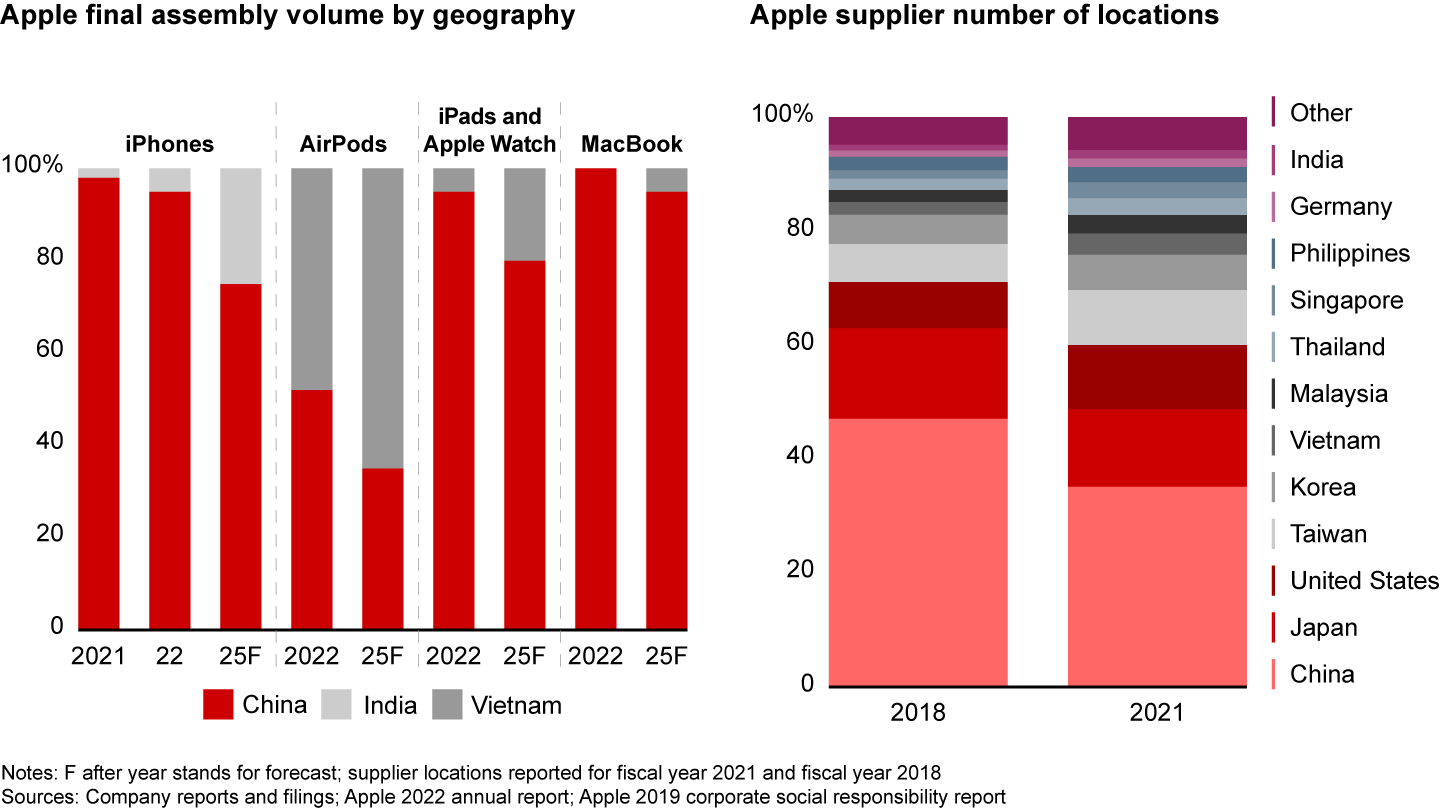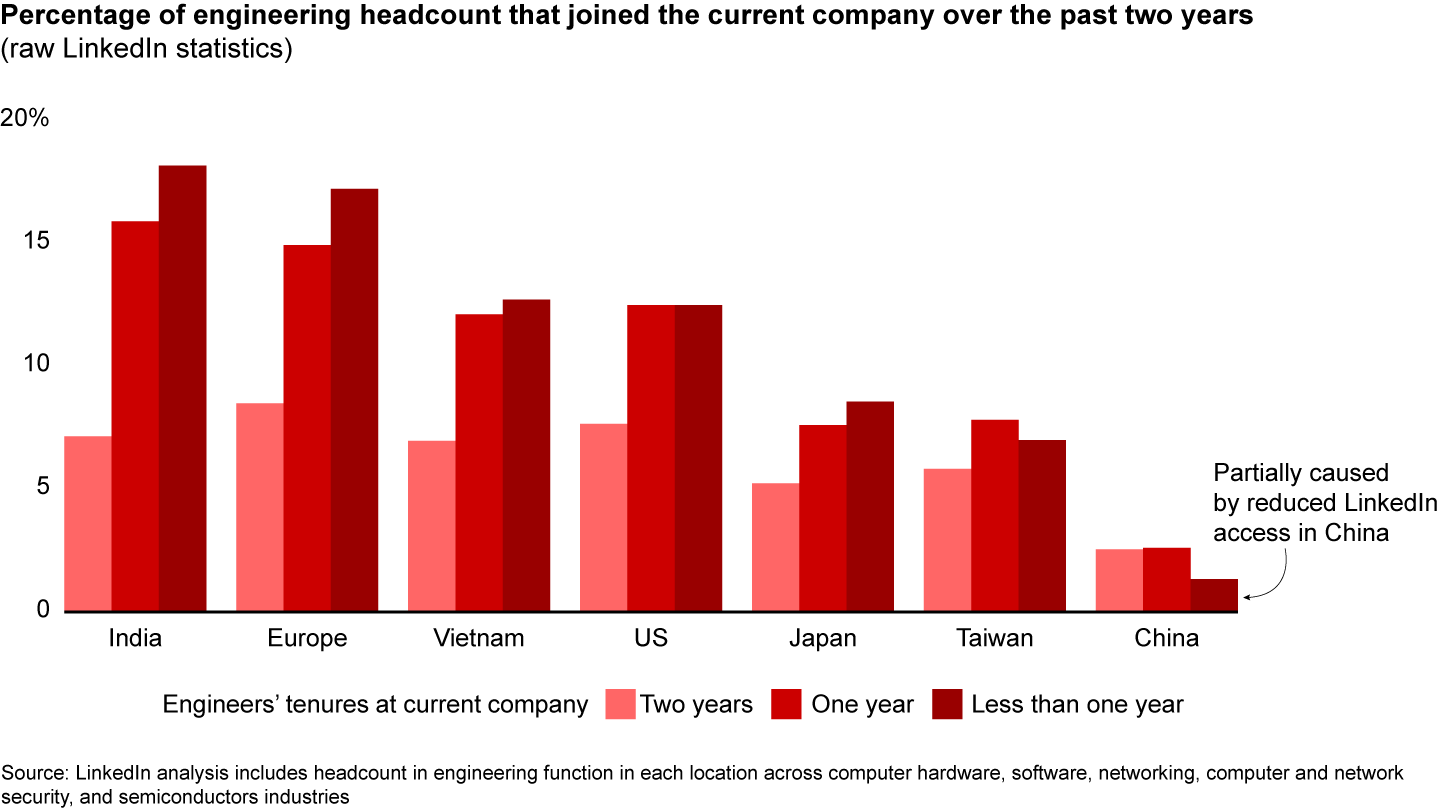Technology Report
 }
}
At a Glance
- Tech companies are diversifying their supply chains, R&D locations, and talent pools in order to build resilience against global shocks.
- The semiconductor industry, for example, is responding to government incentives to make large, long-term investments in fabs in the US, Japan, and Germany.
- These changes will create new technology hubs and shift the competitive landscape—partly as a result, the hiring of engineers is accelerating in India and Europe.
- A decade from now, the global footprint of the technology value chain is likely to look very different, but companies should be evaluating their options today.
This article is part of Bain's 2023 Technology Report.
The shocks of the past few years have awakened tech companies to the risks of restrictive policies and export controls. Most are now moving rapidly to build resilience into their supply chains, primarily by expanding their geographic footprints and creating more flexibility within their talent pools.
Investing in resilience is costly and could take decades. But the good news is that resilience doesn’t mean 100% risk aversion—an approach that would be too expensive and inefficient. Practical resilience means diversifying the most critical aspects of your business while getting closer to end markets.
Beyond supply chains: Disentangling talent and R&D
The initial impulse to be closer to end markets, diversify geographically, and respond to pressures from local government and regulatory bodies led companies first to disentangle their supply chains. Now, they are extending those efforts to R&D, talent, and innovation centers.
Relocating manufacturing and component suppliers. Tech manufacturers that have their facilities concentrated in one region or that sell to markets on the opposite side of the world are boosting resilience and improving efficiency by diversifying their manufacturing footprint to new locations in Asia, Europe, and North America. It will take time for companies to move production, and they will also need to balance the risk of oversupply as new sites come online. The semiconductor industry is incentivizing the build-out of new fabs outside of historical locations, primarily targeted at newer chips at smaller node geometries, but new fabs take three to five years to come online and produce chips in volume. Even downstream original equipment manufacturers and component suppliers that are moving production to new locations will require a few years to materialize and deliver the same standards as original factories.
Apple, for example, has started to diversify its manufacturing base outside of China—and India and Vietnam have been the biggest winners. India is expected to become a major manufacturer of iPhones soon. The percentage of iPhones produced in India grew from 2% in 2021 to about 5% in 2022, and this number is expected to grow to 25%. Several of Apple’s contractors and component suppliers, including Foxconn and Foxlink, are also planning to invest in new capacity in India to support this expansion (see Figure 1).

Chipmaker TSMC has also started to expand its production capacity outside of Taiwan, with announcements to build multiple fabs in the US, Japan, and Germany, investing close to $65 billion. TSMC relies on local subsidies from recently passed legislation in those regions to cover 20% to 50% of the total cost.
In 2021, Lenovo doubled its manufacturing footprint in Monterrey, Mexico, allowing the company to manufacture all data center products for North American customers within a Nafta country. This lets Lenovo manage its supply chain more effectively to better serve its North American customers.
Foreign direct investment in China has gone down, with the notable exception of Tesla, which recently announced that it will open a second factory in Shanghai in 2024 to produce the Megapack battery. This is in addition to its Gigafactory that started production in 2019, which was built to provide local manufacturing for the company’s second biggest market outside of the US. This helps Tesla serve its large customer base in China, avoid tariffs, and source parts locally to reduce costs.
Relocating R&D and talent. Restrictions moved faster than expected to impact talent and R&D. For example, in October 2022, the US Department of Commerce’s Bureau of Industry and Security added new rules restricting the ability of US persons to support the development or production of integrated circuits at certain fabs in China. Tech companies are avoiding single points of failure and tapping markets with concentrations of specific skills (see Figure 2). They are strategically relocating business-critical functions and roles to areas with lower geopolitical risk. Approaches include duplicating high-value capabilities in several locations, documenting at-risk processes in case they need to be replicated in new locations, and hiring more employees in safer geographies.
Partly as a result of these strategies, India and Europe are seeing an acceleration in the hiring of engineers. India has become a thriving location for multinational companies to establish R&D centers in artificial intelligence (AI) because of its large talent pool, which offers vast potential for growth. Among other examples, Fujitsu launched a new AI R&D center, Fujitsu Research of India Private Limited, in 2022 as part of its global innovation strategy.

Implications for technology companies
Given the high cost and time commitment to build resilience, some companies are waiting on the sidelines as others take the first step. While it’s not essential to be the first mover, it’s certainly critical not to be the last to act. The key is to have a plan in place.
- Identify critical risk areas. Across the supply chain (manufacturing, component supplier, R&D, talent), companies should start by assessing which parts of the business are strategically most important and most susceptible to risks, along with identifying critical dependencies and where to build redundancy. Each business unit requires different types of resilience, with varying complexity and potential impact on earnings.
- Evaluate options. In assessing complexity, companies should consider locations where governments are making it easier to do business. Several countries and trading blocs are putting new rules in place and offering subsidies to encourage new, local technology supply chains that use government investment dollars and tax credits. For example, recent regulatory initiatives in India are creating favorable grounds for manufacturing and talent relocation, and in the US and EU, regulations are paving the way for more semiconductor investments.
- Be ready to invest. Tech companies will have to coinvest and share know-how to support the rebalancing of supply chains, aiding in the broader development of new local supplier ecosystems. Specifically, this could include helping key suppliers get approval to build sites in new countries as well as providing the talent, engineering, and management expertise needed to build products to the necessary standards.
- Test the waters. Companies can start with smaller, less important products to assess markets, avoiding the risk of being a late mover. They can move to core products after gaining a foothold in new locations.
A decade from now, the global footprint of the technology value chain will look very different. Today’s investments in resilience are likely to create new hubs and ecosystems while shifting the competitive landscape. Industries may fragment, and new local heroes will emerge. Now is the time to begin making early investments to ensure the resilience of talent and supply chains.

